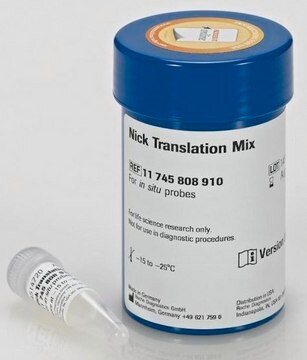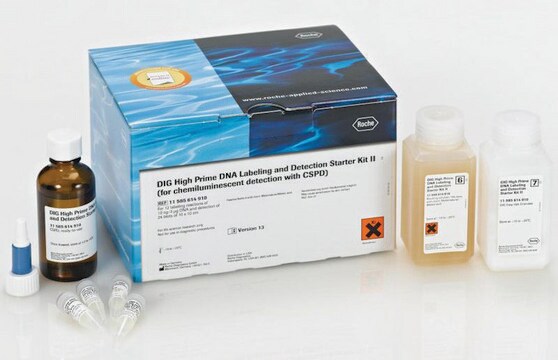11745816910
Roche
DIG-Nick Translation Mix
sufficient for 40 labeling reactions, pkg of 160 μL, suitable for hybridization
Sinônimo(s):
nick translation
About This Item
Produtos recomendados
Formulário
solution
Nível de qualidade
uso
sufficient for 40 labeling reactions
embalagem
pkg of 160 μL
fabricante/nome comercial
Roche
características do produto alternativo mais ecológico
Designing Safer Chemicals
Learn more about the Principles of Green Chemistry.
sustainability
Greener Alternative Product
técnica(s)
hybridization: suitable
categoria alternativa mais ecológica
, Aligned
temperatura de armazenamento
−20°C
Descrição geral
Especificidade
Aplicação
Note: The mix can also be used for filter hybridization techniques, however, for highly sensitive filter hybridization probes, we recommend that you use DIG-High Prime from Roche Applied Science.
For nonradioactive labeling of in situ probes with other haptens and fluorophores, Roche Applied Science offers the Biotin-Nick Translation Mix and the Nick Translation Mix (without nucleotides).
Qualidade
Princípio
E. coli DNA Polymerase I synthesizes DNA complementary to the intact strand in a 5′→3′ direction using the 3′-OH termini of the nick as a primer. The 5′→3′ exonucleolytic activity of DNA polymerase I simultaneously removes nucleotides in the direction of synthesis. The polymerase activity sequentially replaces the removed nucleotides with isotope-labeled or hapten-labeled deoxyribonucleoside triphosphates. At low temperature (+15°C), the unlabeled DNA in the reaction is thus replaced by newly synthesized labeled DNA.
Nota de preparo
Assay Time: 100 minutes
Sample Materials: Supercoiled and linearized plasmid DNA, Supercoiled and linearized cosmid DNA, Purified PCR products.
Note: Denaturing of the template before nick translation is not required.
Outras notas
Código de classe de armazenamento
12 - Non Combustible Liquids
Classe de risco de água (WGK)
WGK 1
Ponto de fulgor (°F)
No data available
Ponto de fulgor (°C)
No data available
Escolha uma das versões mais recentes:
Já possui este produto?
Encontre a documentação dos produtos que você adquiriu recentemente na biblioteca de documentos.
Os clientes também visualizaram
Artigos
Digoxigenin (DIG) labeling methods and kits for DNA and RNA DIG probes, random primed DNA labeling, nick translation labeling, 5’ and 3’ oligonucleotide end-labeling.
Nossa equipe de cientistas tem experiência em todas as áreas de pesquisa, incluindo Life Sciences, ciência de materiais, síntese química, cromatografia, química analítica e muitas outras.
Entre em contato com a assistência técnica








